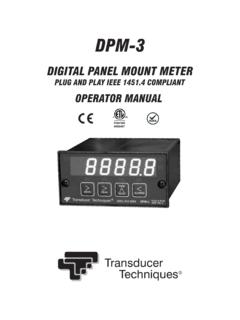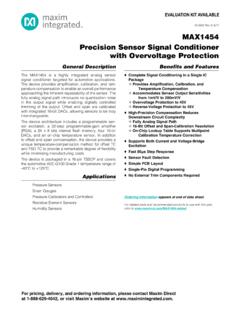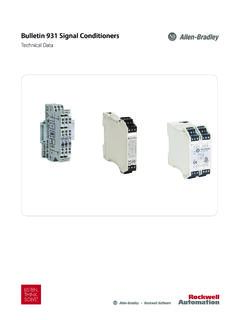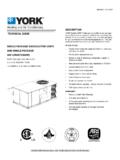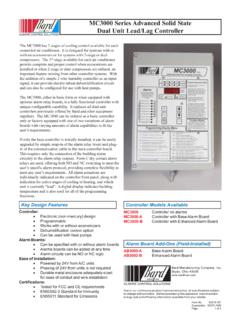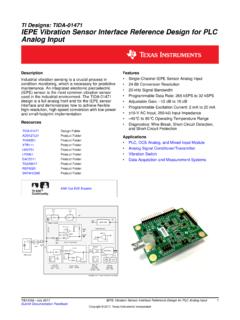Transcription of SMART SENSOR TRANSMITTER - …
1 OPERATOR MANUAL PLUG AND PLAY IEEE COMPLIANTSMART SENSOR TRANSMITTERT echniquesTr a n s d u c e rRSST - 2 - TABLE OF CONTENTS 1. TEDS IEEE INTRODUCTION .. 3 2. SST TRANSMITTER INTRODUCTION .. 4 3. RECEIVING & UNPACKING YOUR TRANSMITTER .. 5 4. SAFETY CONSIDERATIONS .. 5 5. TRANSMITTER FIELD WIRING .. 6 6. READOUTS IN TEDS MODE .. 7 7. PROGRAMMING YOUR TRANSMITTER .. 8 - COMMUNICATIONS .. 9 - SIGNAL & CONTROL INPUTS .. 11 - SCALING .. 12 - FILTERING .. 13 - RELAY ALARMS .. 14 - ANALOG OUTPUT .. 15 - ADDITIONAL PROGRAMMABLE FEATURES .. 15 8. OPENING YOUR TRANSMITTER CASE .. 18 9. MAIN BOARD JUMPER SETTINGS .. 19 10. LOAD CELL SIGNAL CONDITIONER BOARD JUMPER SETTINGS .. 20 11. TRANSMITTER CALIBRATION .. 20 12. DUAL RELAY OPERATION .. 21 13.
2 MODBUS PROTOCOL TRANSMITTER COMMUNICATIONS .. 24 14. CUSTOM ASCII PROTOCOL TRANSMITTER COMMUNICATIONS .. 29 15. SST TRANSMITTER SPECIFICATIONS .. 34 16. ACCESSORIES .. 36 17. WARRANTY .. 38 REVISED 11/2014 - 3 - 1. TEDS IEEE INTRODUCTION Model SST is a TEDS IEEE Plug and Play SMART TRANSMITTER for TEDS IEEE com-pliant Load Cell / Torque Sensors. Such sensors incorporate an EEPROM which specifies the type of SENSOR , its interface, and technical information such as sensitivity, bridge type, excitation, etc. TEDS, or Transducer Electronic Data Sheet, is a set of electronic data in a standardized format defined by the IEEE Standard. The SST TRANSMITTER automatically detects when a TEDS IEEE compliant Load Cell / Torque SENSOR has been connected to it by using a built-in EEPROM detector.
3 It then reads the SENSOR EEPROM, stores the information in its memory, and performs an automatic configuration. The EEPROM may be of any of the following types: DS1973/DS2433, DS2431 or DS1971/ DS2430A. The automatic system configuration function performs all steps needed to calibrate the TEDS IEEE compliant Load Cell / Torque SENSOR and SST TRANSMITTER as a system. This includes the configured precision of either 32 bits, 19 bits or 11 bits and the configured excitation voltage. Interfacing the SST TRANSMITTER to a TEDS IEEE compliant Load Cell / Torque SENSOR is as easy as plugging a mouse into a computer, making it a true plug-and-play experience. - 4 - 2. SST TRANSMITTER INTRODUCTION The SST TRANSMITTER is an extremely accurate and versatile DIN rail TRANSMITTER for Load Cell / Torque Sensors.
4 Standard features include: Accuracy of of full scale 1 count. Update rate to 60/sec in 60 Hz noise environments or 50/sec in 50 Hz noise environments. Full-scale range from mV full scale (1 V resolution) to mV full scale (10 V resolution). Isolated transducer excitation output. 5V at 100mA or 10V at 120mA as selected by TEDS. In non-TEDS operation, the excitation is always 10V. Isolated 4-20 mA, 0-20 mA, 0-10V or -10V to +10V analog output. The signal types are selectable via jumpers. The output tracks the TRANSMITTER s internal digital reading, is scaled in software, and is generated by an ultra-linear 16-bit digital-to-analog converter. Isolated serial data TRANSMITTER output. The TRANSMITTER serial port is default jumpered for RS232 or full-duplex RS485 (same jumper settings).
5 Half-duplex RS485 is also selectable either via internal or external jumpers. Three serial protocols are software selectable: Modbus RTU, Modbus ASCII and Custom ASCII. Modbus allows devices by different manufacturers to be addressed on the same data line. The simpler Custom ASCII protocol is recommended when there are no devices by other manufacturers on the data line. Dual solid state relays rated 120 mA at 140 Vac or 180 Vdc. Isolation to 250V rms is provided for power, signal input, analog output, relay outputs, and communications. Isolation adds safety and avoids possible ground loops. The transducer excitation output is isolated to 50V from signal ground. Internal jumpers are used to select the signal range, communication type, and excitation level.
6 The TRANSMITTER configuration is specified by the model number on the TRANSMITTER label. A user can reconfigure the TRANSMITTER by opening the case and moving jumpers. TRANSMITTER setup is via serial connection to a PC using MS Windows based Instrument Setup Software plus TEDS IEEE when detected. The setup software can be downloaded at no charge from The required trans-mitter to PC interface cable is available for purchase. With a TEDS IEEE compliant Load/ Torque SENSOR , the TRANSMITTER and SENSOR are calibrated as a system. - 5 - 3. RECEIVING & UNPACKING YOUR TRANSMITTER Your TRANSMITTER was carefully tested and inspected prior to shipment. Should the TRANSMITTER be damaged in shipment, notify the freight carrier immediately. In the event the TRANSMITTER is not configured as ordered or is inoperable, please contact Transducer Techniques.
7 4. SAFETY CONSIDERATIONS Warning: Use of this TRANSMITTER in a manner other than specified may impair the protection of the device and subject the user to a hazard. Do not attempt to operate if the unit shows visible damage. Cautions: This unit may be powered from 95-240 Vac 10% or with the worldwide voltage power supply option, or from 12-30 Vac or 10-48 Vdc with the low voltage power supply option. Verify that the proper power option is installed for the power to be used. The 95-240 Vac 10% power connector (P1 Pins 1-3) is colored Green to differentiate it from other input and output connectors. The 12-30 Vac or 10-48 Vdc power connector is colored Black. This TRANSMITTER has no power switch. It will be in operation as soon as power is applied.
8 To avoid dangers of electrocution and/or short circuit, do not attempt to open the case while the unit is under power. To prevent an electrical or fire hazard, do not expose the TRANSMITTER to excessive moisture. Do not operate the TRANSMITTER in the presence of flammable gases or fumes, as such an environment constitutes an explosion hazard. Symbols used: Caution (refer to accompanying documents) Earth (ground) terminal. Caution, risk of electric shock. Both direct and alternating current. Equipment protected throughout by double insulation or reinforced insulation. Operating environment: TRANSMITTER Class II (double insulated) equipment designed for use in Pollution degree 2. - 6 - 5. TRANSMITTER FIELD WIRING - 7 - P6 Wiring Detail 6.
9 READOUTS IN TEDS MODE When a SST TRANSMITTER connected to a TEDS transducer is powered on, the TRANSMITTER reads the data stored in the transducer. The excitation supply is automatically set to the correct value, and the SST then calculates the correct scaling to calibrate the SST and transducer as a system. The jumper on the signal conditioner board must be set for the 50 mV range. See Section 10. If the Maximum Physical Value of the TEDS SENSOR exceeds 100,000, the calculated scale and offset are divided by 10, and the reading is in 10's of units. DPM-3-TRES Reader_Editor Software, which is available from Transducer Techniques as an Accessory (see Section 17), allows the electronic data sheet for the transducer to be read through the RS232 port of the TRANSMITTER and be displayed on a computer screen.
10 The values can be then be modified ( , to display kilograms instead of pounds) and be written back into the transducer. Instrument Setup (IS) Software can be used to further scale the reading or change decimal points. For example, if the full scale of the transducer is 50 pounds, the TRANSMITTER can be programmed to transmit 50, , , or at full scale output or an equivalent value in kilograms. Please see the next section of this manual. - 8 - 7. PROGRAMMING YOUR TRANSMITTER OVERVIEW The SST TRANSMITTER is easily programmed using a PC with an RS232 port and Instrument Setup (IS) software, which provides a graphical user interface. This software is downloadable at no charge from It allows up-loading, editing, downloading and saving of setup data, execution of commands under computer control, listing, plotting and graphing of data.
